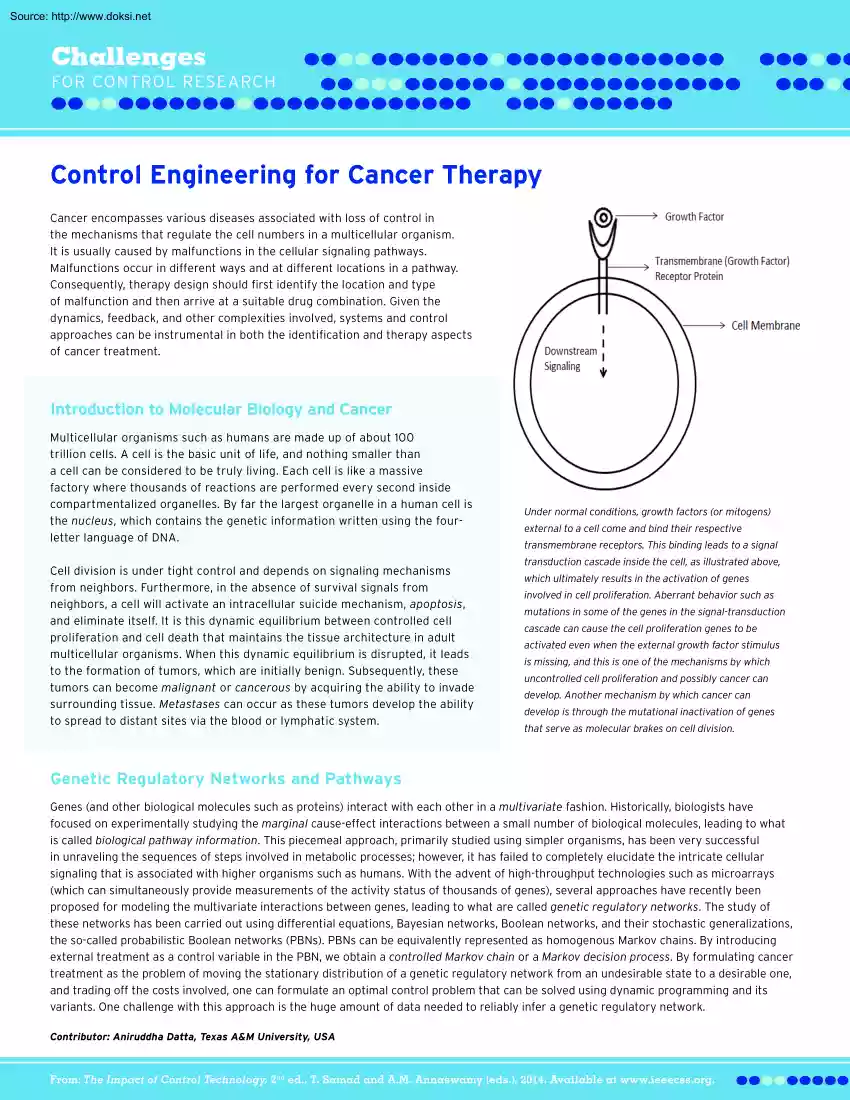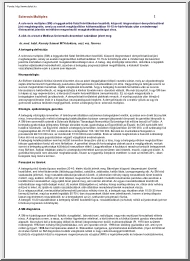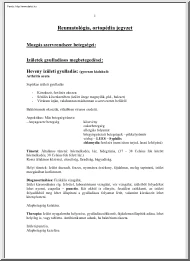Datasheet
Year, pagecount:2014, 2 page(s)
Language:English
Downloads:2
Uploaded:November 23, 2017
Size:817 KB
Institution:
-
Comments:
Attachment:-
Download in PDF:Please log in!
Comments
No comments yet. You can be the first!Most popular documents in this category
Content extract
Source: http://www.doksinet Challenges FOR CONTROL RESEARCH Control Engineering for Cancer Therapy Cancer encompasses various diseases associated with loss of control in the mechanisms that regulate the cell numbers in a multicellular organism. It is usually caused by malfunctions in the cellular signaling pathways. Malfunctions occur in different ways and at different locations in a pathway. Consequently, therapy design should first identify the location and type of malfunction and then arrive at a suitable drug combination. Given the dynamics, feedback, and other complexities involved, systems and control approaches can be instrumental in both the identification and therapy aspects of cancer treatment. Introduction to Molecular Biology and Cancer Multicellular organisms such as humans are made up of about 100 trillion cells. A cell is the basic unit of life, and nothing smaller than a cell can be considered to be truly living. Each cell is like a massive factory where thousands of
reactions are performed every second inside compartmentalized organelles. By far the largest organelle in a human cell is the nucleus, which contains the genetic information written using the fourletter language of DNA. Cell division is under tight control and depends on signaling mechanisms from neighbors. Furthermore, in the absence of survival signals from neighbors, a cell will activate an intracellular suicide mechanism, apoptosis, and eliminate itself. It is this dynamic equilibrium between controlled cell proliferation and cell death that maintains the tissue architecture in adult multicellular organisms. When this dynamic equilibrium is disrupted, it leads to the formation of tumors, which are initially benign. Subsequently, these tumors can become malignant or cancerous by acquiring the ability to invade surrounding tissue. Metastases can occur as these tumors develop the ability to spread to distant sites via the blood or lymphatic system. Under normal conditions, growth
factors (or mitogens) external to a cell come and bind their respective transmembrane receptors. This binding leads to a signal transduction cascade inside the cell, as illustrated above, which ultimately results in the activation of genes involved in cell proliferation. Aberrant behavior such as mutations in some of the genes in the signal-transduction cascade can cause the cell proliferation genes to be activated even when the external growth factor stimulus is missing, and this is one of the mechanisms by which uncontrolled cell proliferation and possibly cancer can develop. Another mechanism by which cancer can develop is through the mutational inactivation of genes that serve as molecular brakes on cell division. Genetic Regulatory Networks and Pathways Genes (and other biological molecules such as proteins) interact with each other in a multivariate fashion. Historically, biologists have focused on experimentally studying the marginal cause-effect interactions between a small
number of biological molecules, leading to what is called biological pathway information. This piecemeal approach, primarily studied using simpler organisms, has been very successful in unraveling the sequences of steps involved in metabolic processes; however, it has failed to completely elucidate the intricate cellular signaling that is associated with higher organisms such as humans. With the advent of high-throughput technologies such as microarrays (which can simultaneously provide measurements of the activity status of thousands of genes), several approaches have recently been proposed for modeling the multivariate interactions between genes, leading to what are called genetic regulatory networks. The study of these networks has been carried out using differential equations, Bayesian networks, Boolean networks, and their stochastic generalizations, the so-called probabilistic Boolean networks (PBNs). PBNs can be equivalently represented as homogenous Markov chains By introducing
external treatment as a control variable in the PBN, we obtain a controlled Markov chain or a Markov decision process. By formulating cancer treatment as the problem of moving the stationary distribution of a genetic regulatory network from an undesirable state to a desirable one, and trading off the costs involved, one can formulate an optimal control problem that can be solved using dynamic programming and its variants. One challenge with this approach is the huge amount of data needed to reliably infer a genetic regulatory network Contributor: Aniruddha Datta, Texas A&M University, USA From: The Impact of Control Technology, 2nd ed., T Samad and AM Annaswamy (eds), 2014 Available at wwwieeecssorg Source: http://www.doksinet Combination Therapy Design Based on Pathway Information Future Challenges in Experimental Validation Biological pathway information, despite its limitations, can also be useful in therapy design. In cases where feedback loops are absent, the pathway can
be modeled as a digital circuit using logic gates. Computer simulation of the digital circuit can aid in identifying where in the pathway signal breakdown can occur using only input/output information. Furthermore, the effect of different anticancer drugs, whose main mechanism of action is to cut off the downstream signaling, can be superimposed on the digital circuit at the known appropriate points of intervention. Thereafter, this circuit can be used to make predictions about the efficacy of different drug combinations. See the figure below for an example. The predictions regarding combination therapy for cancer merit experimental validation, perhaps using cancer cell lines. However, experimental validation must deal with several complexities, such as (i) possible inaccuracies in the pathway model; (ii) the presence of feedback loops that have not been accounted for; (iii) the presence of multiple faults; and (iv) the heterogeneity of cancer tissue. Addressing each of these problems
is a research issue in its own right and could significantly contribute to cancer treatment. Here, it is encouraging to note that issues of this type, such as uncertainty and robustness, have been extensively studied in engineering disciplines such as control theory, although adapting the ideas to the current context will still be a challenge. With the circuit above, the efficacy of drug combinations can be predictedshown here for six drugs and 24 possibilities for signaling breakdown (represented by the numbered gates in the left figure). Left: Digital circuit model of the growth factor signaling pathway. The input signals are the growth factors and a brake on cell division; outputs are proteins/genes reporting on cell proliferation and programmed cell death. Right: Effect of anticancer drugs overlaid on the circuit. For more information: A. Datta and ER Dougherty, Introduction to Genomic Signal Processing with Control, CRC Press, 2007; R Layek et al, Cancer therapy design based on
pathway logic, Bioinformatics, vol. 27, no 4, pp 548-555, 2011; M Vidyasagar, Control System Synthesis: A Factorization Approach, MIT Press, Cambridge, MA, 1985
reactions are performed every second inside compartmentalized organelles. By far the largest organelle in a human cell is the nucleus, which contains the genetic information written using the fourletter language of DNA. Cell division is under tight control and depends on signaling mechanisms from neighbors. Furthermore, in the absence of survival signals from neighbors, a cell will activate an intracellular suicide mechanism, apoptosis, and eliminate itself. It is this dynamic equilibrium between controlled cell proliferation and cell death that maintains the tissue architecture in adult multicellular organisms. When this dynamic equilibrium is disrupted, it leads to the formation of tumors, which are initially benign. Subsequently, these tumors can become malignant or cancerous by acquiring the ability to invade surrounding tissue. Metastases can occur as these tumors develop the ability to spread to distant sites via the blood or lymphatic system. Under normal conditions, growth
factors (or mitogens) external to a cell come and bind their respective transmembrane receptors. This binding leads to a signal transduction cascade inside the cell, as illustrated above, which ultimately results in the activation of genes involved in cell proliferation. Aberrant behavior such as mutations in some of the genes in the signal-transduction cascade can cause the cell proliferation genes to be activated even when the external growth factor stimulus is missing, and this is one of the mechanisms by which uncontrolled cell proliferation and possibly cancer can develop. Another mechanism by which cancer can develop is through the mutational inactivation of genes that serve as molecular brakes on cell division. Genetic Regulatory Networks and Pathways Genes (and other biological molecules such as proteins) interact with each other in a multivariate fashion. Historically, biologists have focused on experimentally studying the marginal cause-effect interactions between a small
number of biological molecules, leading to what is called biological pathway information. This piecemeal approach, primarily studied using simpler organisms, has been very successful in unraveling the sequences of steps involved in metabolic processes; however, it has failed to completely elucidate the intricate cellular signaling that is associated with higher organisms such as humans. With the advent of high-throughput technologies such as microarrays (which can simultaneously provide measurements of the activity status of thousands of genes), several approaches have recently been proposed for modeling the multivariate interactions between genes, leading to what are called genetic regulatory networks. The study of these networks has been carried out using differential equations, Bayesian networks, Boolean networks, and their stochastic generalizations, the so-called probabilistic Boolean networks (PBNs). PBNs can be equivalently represented as homogenous Markov chains By introducing
external treatment as a control variable in the PBN, we obtain a controlled Markov chain or a Markov decision process. By formulating cancer treatment as the problem of moving the stationary distribution of a genetic regulatory network from an undesirable state to a desirable one, and trading off the costs involved, one can formulate an optimal control problem that can be solved using dynamic programming and its variants. One challenge with this approach is the huge amount of data needed to reliably infer a genetic regulatory network Contributor: Aniruddha Datta, Texas A&M University, USA From: The Impact of Control Technology, 2nd ed., T Samad and AM Annaswamy (eds), 2014 Available at wwwieeecssorg Source: http://www.doksinet Combination Therapy Design Based on Pathway Information Future Challenges in Experimental Validation Biological pathway information, despite its limitations, can also be useful in therapy design. In cases where feedback loops are absent, the pathway can
be modeled as a digital circuit using logic gates. Computer simulation of the digital circuit can aid in identifying where in the pathway signal breakdown can occur using only input/output information. Furthermore, the effect of different anticancer drugs, whose main mechanism of action is to cut off the downstream signaling, can be superimposed on the digital circuit at the known appropriate points of intervention. Thereafter, this circuit can be used to make predictions about the efficacy of different drug combinations. See the figure below for an example. The predictions regarding combination therapy for cancer merit experimental validation, perhaps using cancer cell lines. However, experimental validation must deal with several complexities, such as (i) possible inaccuracies in the pathway model; (ii) the presence of feedback loops that have not been accounted for; (iii) the presence of multiple faults; and (iv) the heterogeneity of cancer tissue. Addressing each of these problems
is a research issue in its own right and could significantly contribute to cancer treatment. Here, it is encouraging to note that issues of this type, such as uncertainty and robustness, have been extensively studied in engineering disciplines such as control theory, although adapting the ideas to the current context will still be a challenge. With the circuit above, the efficacy of drug combinations can be predictedshown here for six drugs and 24 possibilities for signaling breakdown (represented by the numbered gates in the left figure). Left: Digital circuit model of the growth factor signaling pathway. The input signals are the growth factors and a brake on cell division; outputs are proteins/genes reporting on cell proliferation and programmed cell death. Right: Effect of anticancer drugs overlaid on the circuit. For more information: A. Datta and ER Dougherty, Introduction to Genomic Signal Processing with Control, CRC Press, 2007; R Layek et al, Cancer therapy design based on
pathway logic, Bioinformatics, vol. 27, no 4, pp 548-555, 2011; M Vidyasagar, Control System Synthesis: A Factorization Approach, MIT Press, Cambridge, MA, 1985





 Just like you draw up a plan when you’re going to war, building a house, or even going on vacation, you need to draw up a plan for your business. This tutorial will help you to clearly see where you are and make it possible to understand where you’re going.
Just like you draw up a plan when you’re going to war, building a house, or even going on vacation, you need to draw up a plan for your business. This tutorial will help you to clearly see where you are and make it possible to understand where you’re going.